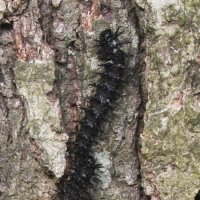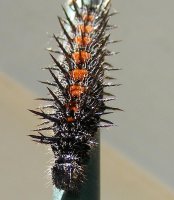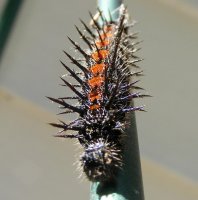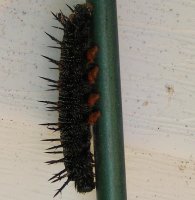You are using an out of date browser. It may not display this or other websites correctly.
You should upgrade or use an alternative browser.
You should upgrade or use an alternative browser.
Caterpillars gone wild!
- Thread starter desertrat
- Start date
T
toppick08
Guest
Just thank God they ain't Gypsy Moth cats......

L
Libertarian
Guest
I cannot dispute that they are mourning cloaks based on the pic because I cannot see them well enough. However, I did not know them to be gregarious. I found one a long time ago all by itself that I reared to adulthood. I'd be interested to find out what these are for sure.Well, not really wild, just being weird. Sort of moving in a slow chain following each other up the tree and back down. I think they will turn out to be Mourning cloak butterflies.
desertrat
0_0
I cannot dispute that they are mourning cloaks based on the pic because I cannot see them well enough. However, I did not know them to be gregarious. I found one a long time ago all by itself that I reared to adulthood. I'd be interested to find out what these are for sure.
I'm not sure at all. It was just the closest thing I could find without digging all day. Check this.
Mourning Cloak Butterfly (Nymphalis antiopa)
Whatever the case may be, the caterpillars emerge from eggs after about 10 days and they will remain together on the same plant. As with all caterpillars, they eat voraciously and grow rapidly. They pass through 5 larval stages, called "instars", by shedding their skins 4 times as caterpillars. The caterpillars seldom move far from being in contact with one of their siblings. If disturbed on a branch, the mass of caterpillars will shake and vibrate in unison, thus, presumably, startling or frightening a potential predator. The bristling spines covering the caterpillars are another good deterrent to predators
Here is a closer picture. I don't see the red dots they mentioned.
Attachments
L
Libertarian
Guest
I'm not sure at all. It was just the closest thing I could find without digging all day. Check this.
Mourning Cloak Butterfly (Nymphalis antiopa)
Here is a closer picture. I don't see the red dots they mentioned.
Oh, I see...they are gregarious until they are ready to pupate. Come to think of it, the one I found was actually crossing the road, and did in fact pupate very soon after I found it. So, the ones in your pic could very well be mourning cloaks. Do you recall what kind of tree that was that the caterpillars were on?
T
toppick08
Guest
Looks like a sweetgum to me.....:shrug:
L
Libertarian
Guest
I'm not sure at all. It was just the closest thing I could find without digging all day. Check this.
Mourning Cloak Butterfly (Nymphalis antiopa)
Here is a closer picture. I don't see the red dots they mentioned.
If you have kids or grandkids, it may be entertaining for them if you took one of those caterpillars and put it in a wide-mouth jar and fed it whatever kind of leaves it usually eats. Just keep a twig and enough space in there for it to pupate when its ready, and keep it moist enough inside the jar to prevent it from drying out but not wet enough to cause mold to grow. Judging by the size, it should be a butterfly within a month. You could then identify it and let it go free.
Larry Gude
Strung Out
Misleading tread title. 
I thought you meant this;

I thought you meant this;
L
Libertarian
Guest
LOL...I think I remember that movie...I was like 7 years old when I watched a movie with my family about a bulldozer that operated by itself. I think it got in a fight with another piece of equipment. Thanks for sharing that and bringing back that memory.Misleading tread title.
I thought you meant this;
L
Libertarian
Guest
No, they are not Eastern tent caterpillars. Eastern tent caterpillars have large prominent white stripes down their backs.These are Eastern Tent Caterpillars. This is what they do before they pupate.
belvak
Happy Camper
Well, not really wild, just being weird.
Okay, so they drank their Kool-Aid...

If you have kids or grandkids, it may be entertaining for them if you took one of those caterpillars and put it in a wide-mouth jar and fed it whatever kind of leaves it usually eats. Just keep a twig and enough space in there for it to pupate when its ready, and keep it moist enough inside the jar to prevent it from drying out but not wet enough to cause mold to grow. Judging by the size, it should be a butterfly within a month. You could then identify it and let it go free.
My Sister did this when we were little. She took a cracker box and put a bunch of leaves and twigs in it with a neat "caterpillar" she found. A few weeks later, we both woke up freaking out. Her little caterpillar had morphed into a Luna Moth!!
 That darn thing was HUGE and flapping all around our bedroom.
That darn thing was HUGE and flapping all around our bedroom. 
She gave up caterpillars and started squishing bumble bees in her hands after that!!
 Of course, she didn't do that too long either, after she got stung on her palm and her arm swelled up to the shoulder! God do I ever miss her! She passed away in 1980 at the age of 18.
Of course, she didn't do that too long either, after she got stung on her palm and her arm swelled up to the shoulder! God do I ever miss her! She passed away in 1980 at the age of 18. 
D
dems4me
Guest
Here is a closer picture. I don't see the red dots they mentioned.
Like these? I saw some of these this week. I havn't had time to identify them. Are these the ones with the red dots :shrug:
Attachments
Larry Gude
Strung Out
LOL...I think I remember that movie...I was like 7 years old when I watched a movie with my family about a bulldozer that operated by itself. I think it got in a fight with another piece of equipment. Thanks for sharing that and bringing back that memory.
If memory serves, they, the men, use a steam shovel to fight back and lure it on a steel mat and use a generator to electrocute the KILLDOZER.
belvak
Happy Camper
Like these? I saw some of these this week. I havn't had time to identify them. Are these the ones with the red dots :shrug:
Dems, think this is the one you found. Hubby thought he recognized it, and I found it on a site listed as one of the stinging caterpillars!
 Nymphalis antiopa - Wikipedia, the free encyclopedia
Nymphalis antiopa - Wikipedia, the free encyclopediaSpiny Elm Caterpillar (Nymphalis antiopa) (Photo 18)
The full-grown caterpillar is about 2 inches long. Its body is black with numerous white flecks and a row of red spots down the back; prolegs are red. Larvae feed on foliage of elm, cottonwood, hackberry, and willow. In our area, it is most often found on elm and willow. In Lee County, caterpillars are usually seen in April and May; however, a second brood may occur, with larvae possibly present again in August-September.
D
dems4me
Guest
Dems, think this is the one you found. Hubby thought he recognized it, and I found it on a site listed as one of the stinging caterpillars!Nymphalis antiopa - Wikipedia, the free encyclopedia
Spiny Elm Caterpillar (Nymphalis antiopa) (Photo 18)
Thanks! Good to know!! I just generally live and let live on stuff like that. It was pretty though. I didn't know eastern tent catepillars were stinger catepillars though. Good to know on that too! Thanks!
belvak
Happy Camper
Thanks! Good to know!! I just generally live and let live on stuff like that. It was pretty though. I didn't know eastern tent catepillars were stinger catepillars though. Good to know on that too! Thanks!
Yeah, that's sort of weird. I mean, we used to let them crawl all over us when we were young (and stupid)! Guess we were just lucky? Or maybe they are a different variety of tent caterpillar? Anyway, that pic looke just like yours, so I just wanted to let you know!

D
dems4me
Guest
Yeah, that's sort of weird. I mean, we used to let them crawl all over us when we were young (and stupid)! Guess we were just lucky? Or maybe they are a different variety of tent caterpillar? Anyway, that pic looke just like yours, so I just wanted to let you know!
Thanks! I play with them all time moving them out of my way, etc...
 Thanks again for the link on the spiney ones!!
Thanks again for the link on the spiney ones!! 
W
Wenchy
Guest
I hate it when he takes pictures of gross things he finds in our yard.
My turtle is hungry and will be grateful for any contributions (excluding snakes, unless chopped into bite-sized pieces)





